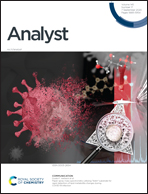C-Terminally tagged NA in replication-competent influenza A viruses reveals differences in glycan profiles between NA and HA†
Abstract
Glycans attached to the viruses regulate their pathogenicity, immunogenicity, and antigenicity. We have previously shown that lectin microarray provided an easy and highly sensitive platform for analyzing glycan profiles of hemagglutinin (HA) of influenza A viruses in culture supernatants. On the other hand, the system is not applicable for neuraminidase (NA), the other viral glycoprotein of influenza A viruses, due to the limited availability of specific antibodies used to detect NA in the lectin microarray. Accordingly, we established replication-competent viruses harboring the short peptide-tag sequence at the C-terminus of NA in this study. The generated viruses underwent normal proliferation cycles and showed similar properties to the wild-type viruses. Lectin microarray analyses of the tagged NA enriched from the viral particles showed that glycan profiles of NA were mostly occupied by mannose-type glycans. Interestingly, the profiles were distinct from those of HA separated from the same particle preparation, in which core-fucosylated complex-type N-glycans terminating with non-sialylated N-acetyllactosamine were dominant. Collectively, this study provides novel platforms for the analyses of the distinction between the glycan profiles of NA and HA, and contributes to a better understanding of later stages of the viral life cycles through analyzing the glycans attached to NA.



 Please wait while we load your content...
Please wait while we load your content...